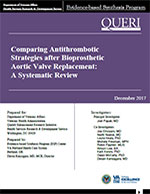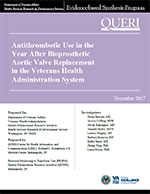
Principal Investigator: Joel Papak, MD
Co-Investigators: Joe Chiovaro, MD; North Noelck, MD; Laura Healy, PhD; Michele Freeman, MPH; Robin Paynter, MLIS; Allison Low, BA; Karli Kondo, PhD; Owen McCarty, PhD; Devan Kansagara, MD
Download PDF: Complete Report, Executive Summary, Report, Appendices

This report is a companion to the systematic review comparing antithrombotic strategies after bAVR produced in 2017 by the Evidence-based Synthesis Program Center in Portland, Oregon
The use of bioprosthetic aortic valves placed surgically and with a transcatheter approach is a common treatment for valvular heart disease. While most patients are treated with anticoagulant and/or antiplatelet therapy for a period of time after the procedure, the optimal antithrombotic regimen and duration after placement of a bioprosthetic aortic valve is unclear, and both guideline recommendations and practice patterns vary significantly. This systematic review aims to broadly summarize the comparative benefits and harms for various anticoagulation strategies following surgical or transcatheter implantation of a bioprosthetic aortic valve, and to determine whether effects differed according to thromboembolic risk profile or concomitant procedure.
Key Questions 1 and 2: What are the comparative benefits and harms of antithrombotic strategies for patients who have had bAVR?
KQ1-2A. Do the benefits/harms differ according to thromboembolic risk profile?
KQ1-2B. Do the benefits/harms differ according to concomitant procedure (eg CABG)?
Key Question 3: What are the comparative benefits and harms of antithrombotic strategies for patients who have TAVR?
KQ3A. Do the benefits/harms differ according to thromboembolic risk profile?
KQ3B. Do the benefits/harms differ according to concomitant procedure (eg, CABG)?
Comparing Antithrombotic Strategies after Aortic Valve Replacement (Management eBrief)
Comparing Antithrombotic Strategies after Bioprosthetic Aortic Valve Replacement: A Systematic Review (Cyberseminar)
Papak J, Chiovaro J, Noelck N et al. Antithrombotic Strategies After Bioprosthetic Aortic Valve Replacement: A Systematic Review. Annals of Thoracic Surgery. 2019;107(5):1571-1581. https://doi.org/10.1016/j.athoracsur.2018.10.016
Bravata DM, Coffing JM, Kansagara D, et al. Association Between Antithrombotic Medication Use After Bioprosthetic Aortic Valve Replacement and Outcomes in the Veterans Health Administration System. JAMA Surgery. 2019;154(2):e184679. doi: 10.1001/jamasurg.2018.4679. PMID: 30586138